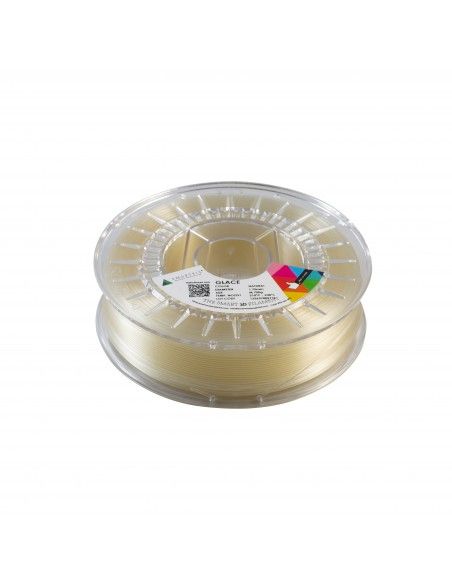+34 953 041 993 / Mon - Thur from 8am to 2pm
and 3pm to 5pm - Friday 07am to 3pm
GLACE
Thermoplastic polymer with mechanical properties superior to ABS and PLA, good impact resistance and high flexibility. Without warping so large parts can be manufactured with excellent quality. In addition, it can be chemically polished with alcohol in such a way that pieces with high transparency and a completely smooth finish can be manufactured.
It is a filament to which alcohol can be applied and thus achieve different effects. Completely transparent pieces can be manufactured or surface polished to remove rough surfaces and thus achieve a pearlescent effect.
In addition, due to the fusion between layers, the piece increases its structural strength, forming a continuous solid and achieving high tightness.
How to make transparent pieces?
It is necessary to take into account to print pieces of great transparency, which must be pieces of a single layer, so that the alcohol can penetrate homogeneously into the material. If you want to achieve good mechanical resistance, it is recommended to use nozzles of 0.8mm or higher. In this way we will achieve a wall of sufficient thickness to maintain the desired mechanical resistance.
For a greater effect of transparency in the finish using Glace, it is recommended to print using the "Spiral vase" option.
1. APPLY ALCOHOL TREATMENT
Apply the treatment with alcohol (ethyl or isopropyl) with a concentration higher than 70 °. The higher the alcohol content, the faster the process, although it is also more difficult to control. The different application methods are as follows:
Direct application by immersion: Immerse the piece directly in alcohol, so that the entire surface comes into contact. Remove the piece and then, and let it drain so that the alcohol can evaporate freely. It must be taken into account that this method is very aggressive, and if the alcohol penetrates too much into the piece, it can soften by varying the geometry.
Evaporative application: In a closed container, insert a paper soaked in alcohol placed so that it is around the piece. Then we introduce the piece taking great care that they do not come into contact. Close the container and allow evaporation to affect the piece, achieving the desired effect.
2. LEAVE THE PART AT REST
Leave the piece to rest inside the container. Once the piece has been impregnated in alcohol, let it dry in the air, depending on the amount of alcohol absorbed by the piece it can soften a little, when the alcohol has completely evaporated the piece will return to its normal state.
Following the previous steps, we managed to dissolve the surface layer of the piece, achieving a perfect union between layers and forming a continuous solid, which allows the material to acquire its transparency.
HOW TO POLISH A PIECE
To smooth the surface of the part, the previous process can be applied to parts with any geometry. In this case, care must be taken when immersing in alcohol because it can get inside the filling of the piece, affecting the material too much and compromising its integrity.
- Print the piece using Glace.
- Apply the alcohol treatment (ethyl or isopropyl) by the following methods:
- Direct application by immersion.
- Direct application by tools. (sprayed, applied with a brush, etc.)
- Evaporative application
- Leave the piece to rest so that the alcohol evaporates, an excess of alcohol can soften too much material.
You might also like









